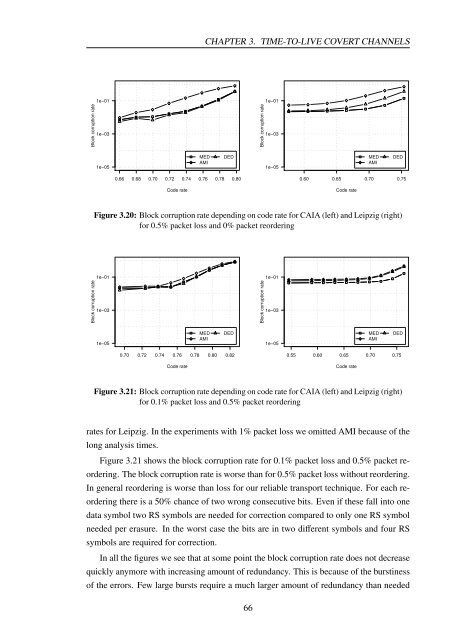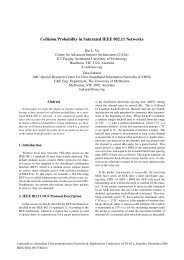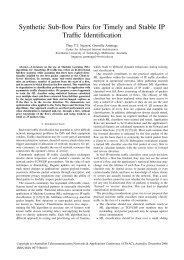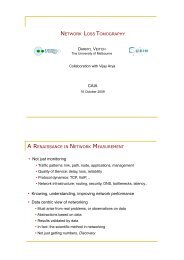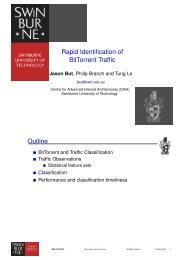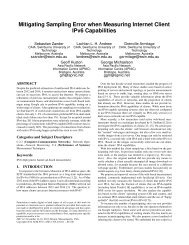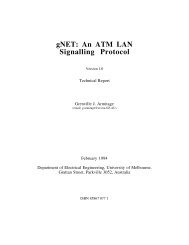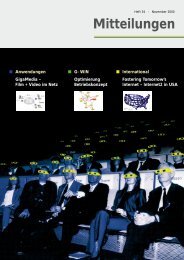Chapter 3 Time-to-live Covert Channels - CAIA
Chapter 3 Time-to-live Covert Channels - CAIA
Chapter 3 Time-to-live Covert Channels - CAIA
You also want an ePaper? Increase the reach of your titles
YUMPU automatically turns print PDFs into web optimized ePapers that Google loves.
Block corruption rate<br />
Block corruption rate<br />
1e−01<br />
1e−03<br />
1e−05<br />
●<br />
●<br />
●<br />
●<br />
0.66 0.68 0.70 0.72 0.74 0.76 0.78 0.80<br />
●<br />
Code rate<br />
●<br />
CHAPTER 3. TIME-TO-LIVE COVERT CHANNELS<br />
MED<br />
AMI<br />
●<br />
DED<br />
●<br />
●<br />
●<br />
●<br />
●<br />
0.60 0.65 0.70 0.75<br />
Code rate<br />
Figure 3.20: Block corruption rate depending on code rate for <strong>CAIA</strong> (left) and Leipzig (right)<br />
for 0.5% packet loss and 0% packet reordering<br />
1e−01<br />
1e−03<br />
1e−05<br />
● ●<br />
● ●<br />
●<br />
Code rate<br />
●<br />
●<br />
MED<br />
AMI<br />
●<br />
DED<br />
0.70 0.72 0.74 0.76 0.78 0.80 0.82<br />
●<br />
Block corruption rate<br />
1e−01<br />
1e−03<br />
1e−05<br />
●<br />
MED<br />
AMI<br />
● ● ● ● ● ● ● ●<br />
●<br />
DED<br />
0.55 0.60 0.65 0.70 0.75<br />
Code rate<br />
Figure 3.21: Block corruption rate depending on code rate for <strong>CAIA</strong> (left) and Leipzig (right)<br />
for 0.1% packet loss and 0.5% packet reordering<br />
rates for Leipzig. In the experiments with 1% packet loss we omitted AMI because of the<br />
long analysis times.<br />
Figure 3.21 shows the block corruption rate for 0.1% packet loss and 0.5% packet re-<br />
ordering. The block corruption rate is worse than for 0.5% packet loss without reordering.<br />
In general reordering is worse than loss for our reliable transport technique. For each re-<br />
ordering there is a 50% chance of two wrong consecutive bits. Even if these fall in<strong>to</strong> one<br />
data symbol two RS symbols are needed for correction compared <strong>to</strong> only one RS symbol<br />
needed per erasure. In the worst case the bits are in two different symbols and four RS<br />
symbols are required for correction.<br />
In all the figures we see that at some point the block corruption rate does not decrease<br />
quickly anymore with increasing amount of redundancy. This is because of the burstiness<br />
of the errors. Few large bursts require a much larger amount of redundancy than needed<br />
66<br />
Block corruption rate<br />
1e−01<br />
1e−03<br />
1e−05<br />
MED<br />
AMI<br />
●<br />
DED<br />
●<br />
●


